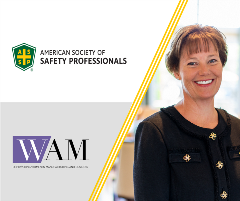Empathy is a powerful tool toward improving the safety, health and well-being of workers,  regardless of gender or social standing. By trying to see things from their employees’ point of view and better understand each individual’s experience, employers can then take proactive steps to meet the needs of every employee.
regardless of gender or social standing. By trying to see things from their employees’ point of view and better understand each individual’s experience, employers can then take proactive steps to meet the needs of every employee.
The U.S. labor force is made up of nearly 160 million people of different genders, races and ethnic and socioeconomic backgrounds. Examining workplace gender dynamics and how those impact workers, both personally and professionally, allows employers, safety professionals and others to work to develop a more diverse and inclusive workplace that supports employees of different backgrounds.
“Gender is something that permeates our culture on all sorts of different levels,” says Cori Wong, Ph.D., assistant vice president for gender equity within the office of the vice president for diversity at Colorado State University. “Our task is to be able to see how and where gender norms, biases, behaviors or expectations can actually shape the world we live in.”
Wong identifies four keys to gender equity or “lenses” through which to view gender and marginalized groups in order to improve diversity and inclusion in the workplace.
1. Think About Intersectionality
First coined by scholar Kimberlé Williams Crenshaw, intersectionality refers to the ways in which systems of oppression interact and overlap with one another. For example, someone could be marginalized because of their gender identity, race, nationality, sexual orientation or disability, and many individuals are part of more than one marginalized group.
“Intersectionality is a conceptual tool that helps us better see how systems of oppression intersect with one another, and because of that, create qualitatively different experiences,” says Wong.
Viewing gender through this lens allows others to better understand the life experiences of different individuals and groups and how they have been marginalized in society. Wong emphasizes that the aim of taking an intersectional perspective is to be as inclusive as possible, not just narrow in on some more prominent experiences that often receive greater focus.
“If you really want to create a more inclusive culture and support diverse populations, you have to look at those who are the most marginalized,” she adds. “When we address the needs of those who are most marginalized, we are more effective at supporting the groups that are marginalized in total.”
2. Break Down Barriers
Obstacles exist throughout society that can keep people from receiving opportunities or reaching their full potential. By taking a comprehensive look at the organizational structure and where such barriers may exist, employers can then take proactive steps to help remove them.
“Employers need to recognize and elevate the skills, talents and capabilities that people already have, and remove the barriers that are inhibiting them from being able to actualize and embody their skills and talents,” says Wong.
She adds that empowerment is one thing, breaking down barriers is another. While an organization may provide support, resources and training to help an employee assimilate to the existing culture, it doesn’t necessarily focus on changing the culture itself or remove the barriers that prevent people from succeeding.
“Removing barriers and offering support through creating a more inclusive culture is a much more effective way to advance change and inclusion,” says Wong. “It goes beyond an empowerment model that focuses on getting employees to fit into a culture or to work harder to succeed in a culture that ultimately is still not supportive of their success in it.”
3. Foster Better Interpersonal Communication
Intentionally or unintentionally, a persons’ bias or lack of understanding about the circumstances that their colleagues face can show itself in the workplace. This can occur without the individual really thinking about the impact their behavior or actions may have on marginalized coworkers.
From the way meetings are run, to certain employees not being invited to meetings, to someone being interrupted while speaking, unconscious bias and microaggressions can surface in the workplace in many ways.
Wong encourages employers to conduct training on unconscious bias and identifying microaggressions so that employees better understand how their actions and attitudes can impact marginalized coworkers. This can elevate understanding of these issues and help create a culture where employees will interrupt problematic practices and speak up on behalf of others who are marginalized.
“We have to help people realize that they could be inadvertently be doing things on a daily basis that only exacerbate the kind of isolation or alienation that some people might feel because of their identities and their backgrounds,” she says.
4. Examine Policies and Procedures
Workplace culture starts at the top, so it is up to organizational leadership to determine how the current structure affects marginalized workers. Policies, how resources are allocated and how decisions are made directly affects every worker.
Every individual has circumstances that should be taken into account as policies and procedures are drafted. Wong stresses the importance of specificity when writing policies and procedures to help ensure that marginalized populations are considered.
“We assume that neutral language means that a policy is equally supportive of everyone,” she says. “But that neutrality can code can certain biases or inequities that actually need to be corrected.”
By involving marginalized individuals and groups in the conversation, conducting active outreach and gathering their input on how policies can better support them, organizations can begin to see the bigger picture of how they can make improvements across the entire operation.
“If we assume everyone is the same and we write our policies in that way, then we’ll actually end up inadvertently excluding people,” says Wong. “You need to have policies in place that equitably support different people's needs.”
In terms of workplace safety, these issues can manifest themselves in various ways. For instance, if most workers on a particular job site are men, those making the purchasing decisions for PPE may not consider the needs of women in the workplace and whether the equipment will meet their needs as well. Furthermore, the way certain tasks or processes are designed may make it more difficult for women to do those tasks safely and effectively.
“The influence of the kind of assumptions of ‘who is the norm’ and how the world gets built around them could mean that certain equipment doesn’t actually fit peoples’ bodies or that the machinery they’re using isn’t at a height that is suitable for them,” says Wong.
Issues such as improperly-fitting PPE, a lack of leadership positions and workplace violence continue to disproportionately affect women in the workplace. Gathering the perspectives of women on how to improve the organizational culture and support marginalized workers can help break down barriers and foster better communication among your workforce, leading to safer, more diverse and inclusive workplaces.
 This article is derived from the first episode of The WAM Podcast’s special 6-episode ASSP series, hosted by ASSP CEO Jennifer McNelly.
This article is derived from the first episode of The WAM Podcast’s special 6-episode ASSP series, hosted by ASSP CEO Jennifer McNelly.
Listen to the full episode here. Click here for bonus content from the podcast on the importance of diversity and inclusion in creating safer workplaces.
Related Links
ASSP Report: Women and Safety in the Modern Workplace
Inclusive & Gender Equal Protection: Protecting Workers’ Reproductive Health
Pregnant Employees: Special Considerations for Protecting Their Safety & Health
Standing Up: Redesigning the Workplace to Address Obesity
The Aging Workforce: Using Ergonomics to Improve Workplace Design